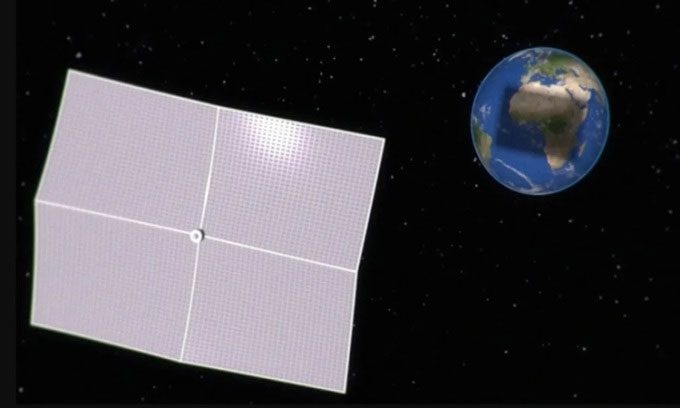Introducing gigantic umbrellas into the space between Earth and the Moon to block radiation is a new solution proposed by American scientists aiming to cool down the planet.
Earth is currently experiencing the hottest period in its history, and humanity is seeking ways to halt global warming. A group of astronomers and physicists has suggested a sci-fi-like potential idea: using a massive umbrella floating in space. Their concept is to create a sunshade and launch it to a point between Earth and the Sun to block a small portion of solar radiation, enough to address the warming issue.

Simulation of the idea of using an umbrella the size of Argentina to block solar radiation. (Image: Technion Institute of Technology)
A research team led by Yoram Rozen, a physics professor and director of the Asher Space Research Institute at the Technion – Israel Institute of Technology, has shared that they are ready to create a prototype that demonstrates the effectiveness of this idea. To block the necessary amount of solar radiation, the shield needs to be approximately 2.6 million square kilometers, equivalent to the area of Argentina. Such a shield would weigh at least 2.5 million tons, making it too heavy to launch into space. Therefore, the project will include a series of smaller shields that do not completely block sunlight but can cast shadows on Earth. According to Rozen, his team is prepared to design a prototype shield larger than 9.3 square meters at a cost of $10 – $20 million, as reported by Futurism on February 3.
Opponents of the idea argue that the shield does not help stop the burning of coal and fossil fuels. Even if emissions from fossil fuels were to drop to zero immediately, the carbon dioxide trapped by heat in the atmosphere would still remain. Additionally, it is costly and cannot be implemented quickly enough to keep pace with the rate of climate change. Furthermore, a solar storm or collision with a rogue celestial body could also destroy the shield, leading to a rapid warming of Earth’s climate.
Scientists estimate that blocking just about 2% of solar radiation is enough to reduce Earth’s temperature by 1.5 degrees Celsius and keep it within permissible climate limits. Due to the worsening climate crisis, interest in solar shields has increased, prompting researchers to propose a wider variety of ideas. A recent study from the University of Utah explored the possibility of dispersing dust in space, while a team of experts at the Massachusetts Institute of Technology is examining bubble shields. Last year, Istvan Szapudi, a researcher at the University of Hawaii’s Institute of Astronomy, proposed tethering a large solar shield to an asteroid.


















































